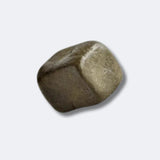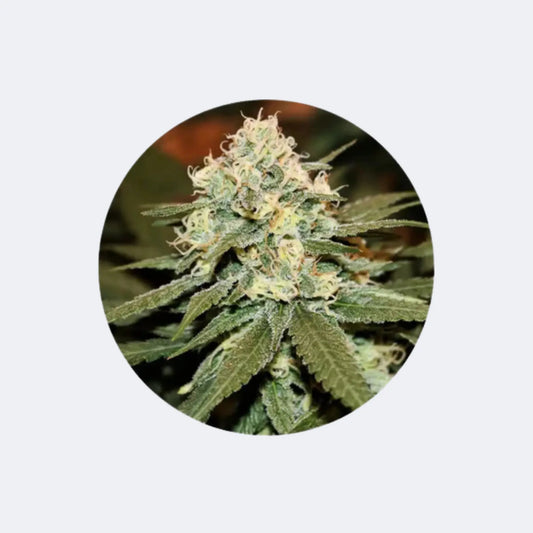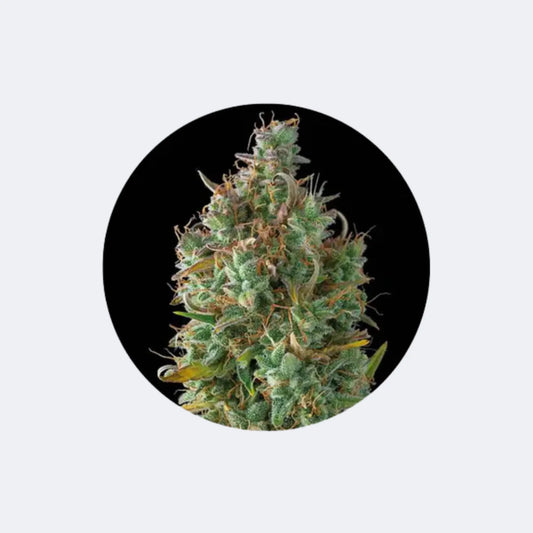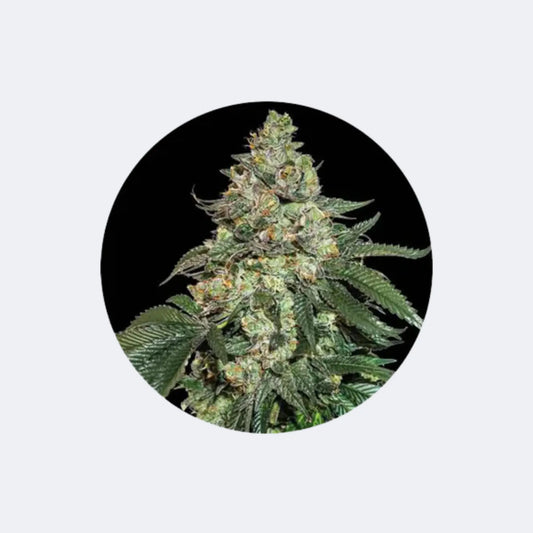
Pests in cannabis cultivation
Andreas LeschkeShare blog post
Pest control in cannabis cultivation
"What measures can help if parasites infest your cannabis plants?"
There are numerous parasites that can only complete their life cycle and reproduce by infesting and feeding on plants. Unfortunately, I've often been asked, in cases of acute pest infestations, how serious such an infestation is and whether it can affect yields.
It is best not to ask yourself or others such questions, but rather to ask yourself how bad it would be for us humans if we were eaten alive by parasites that partly prevent us from eating and/or harm us in other ways!
This makes it clear to everyone that it at least means that the plant is suffering from chronic stress. This can not only reduce flower yields, but in the worst case scenario, by destroying the root system or causing the plant to become weedy, it can even lead to no more yields of your beloved cannabis flowers. Therefore, immediate action should be taken in the event of an acute parasite infestation.
Given the sheer number of pests, it's unfortunately impossible for me to list them all and the countermeasures for them. For this reason, I'll limit myself to the four most common pests, as every grower will have to contend with these parasites sooner or later.
From experience, the pests that occur most frequently in our area are fungus gnats, aphids, thrips, and spider mites, which we will now discuss.

1. "Fungus gnat" on the cannabis plant
(small annoying flies that are often confused with fruit flies)
Many who have never encountered this parasite initially think they're just harmless fruit flies buzzing around their weed plants. This is a gross misconception.
Fruit flies, as the name suggests, feed on fruit. This fact alone should tell you that they aren't fruit flies, because your cannabis plant doesn't contain any fruit that would be of interest to fruit flies.
The fungus gnat, on the other hand, lays its eggs in the nutrient soil of your plant, where small larvae hatch and attack the roots of your beloved cannabis plant before pupating.
After approximately 13 days, the larva enters pupation and transforms into an adult fungus gnat. Once this occurs, the fungus gnat emerges from the soil to mate again within 1-5 days.
After mating, a fungus gnat is capable of laying up to 160 eggs and prefers warm, humid, and dark conditions, making your soil ideal for the plant. Based on these facts, it can be deduced that just a few of these parasites can become a real plague within 14 days, and action should be taken quickly.
To determine the infestation and its concentration, yellow cards or yellow stickers are recommended. These attract the adult fungus gnats, where they then stick. This acts as a kind of "trap," but is not sufficient to combat the infestation, as you can never catch the entire infestation.
There are numerous household tips for controlling fungus gnats. Personally, I don't recommend any of these measures, as each of these household measures continues to cause unnecessary stress to the plant and wastes valuable time that should be spent growing and developing.
Please also keep in mind that with automatics there is NO time for the plant to regenerate and develop further, as they enter the flowering phase after just a few weeks, regardless of size and development.
As a "tried-and-tested" household remedy, it's often recommended to stop watering the soil in the pot until it has hardened on top and the fungus gnats can no longer bury their eggs in the soil. This trick has the same function as gravel or bird sand, which is also recommended as a household trick.
Gravel, as well as bird sand, have the property that they do not mix with the soil and so the fungus gnat no longer has the opportunity to lay its eggs in the soil through this layer of sand.
Regardless of whether the soil on top has dried out hard or gravel or bird sand has been applied as a barrier to fungus gnats, you can then only water the plant minimally by pouring water into the saucer so that the water has to be drawn up from the bottom.
A temporary lack of water is the result of this measure, which inhibits growth and puts additional stress on the plant in addition to the current parasite infestation.
Another home remedy for fungus gnats is to add baking powder or baking soda to the watering water to combat the larvae. You can either add the baking powder directly to the water or spread it over the potting soil using a sieve to moisten it. The larvae ingest it and die.
However, this method only works if you use baking powder or baking soda at the very beginning of the parasite infestation, because baking soda has the property of critically increasing the pH value of your plants' nutrient soil, which in turn is harmful to your plants.
For this reason, this method is risky and only helps minimally in the case of a full-blown invasion of fungus gnats, so that it cannot combat the infestation effectively and quickly enough.
I would also avoid methods such as coffee or coffee grounds, as I have often seen the soil start to mold and this spread to the plants.
In my opinion, sticking match heads into the soil is also not recommended, as the sulfur increases the sodium content of the substrate, which impairs growth if the EC value (equivalent to salt content) limits are exceeded.
I think everyone should now understand why I reject household remedies and prefer to use beneficial insecticides instead. Unlike household remedies, beneficial insecticides won't cause any harm or stress to your plant, which is beneficial for the development of your beloved cannabis plant.
While a few years ago one had to struggle with household resources because the beneficial insect "nematodes" were only available for professional gardening and vegetable gardening, these beneficial insects have also been available for private use for a few years now.
Nematodes are small threadworms that hatch within a few days and search for food. They invade living larvae and secrete their symbiotic bacteria. The pest dies a few days later. The nematodes then continue to reproduce in the dead fungus gnat larvae, seeking new living hosts after about two weeks.
Application is incredibly simple. Simply add the "nematode powder" to the watering system and water the affected plants. After just 1-2 weeks, a rapid decline in the number of parasites will be noticeable, and after another 2 weeks, the infestation should be completely eradicated.
Nematodes (like other beneficial insects) are living organisms, so you can't buy them locally at a hardware store, garden center, etc., but must order them online. Even if you find "nematodes" at a garden center, they're always just order cards and must be requested online.
Usually, the nematodes will be in your mailbox 2-3 days after ordering.

2. The "aphid"
As the name suggests, aphids are pests that primarily attack the leaves of plants, but can also infest other parts of the plant. They then suck out sugary plant sap from the affected areas.
This vampirism of the aphids deprives the plant of important nutrients, which results in the plant becoming weakened and its development being massively slowed down.
Aphids can be identified when infested on the plant. They are small green or yellow insects, which can rarely be black or brown, and are found on the leaves and stems of the plant. Depending on the species, they are between three and seven millimeters long.
A very common household remedy is to use dish soap mixed with water and spray the plant. The trick here is to create a soapy, slippery surface, which prevents the aphids from finding a foothold and attacking the plant.
THIS IS STRONGLY ADVISED AGAINST!!!
Dishwashing detergents contain dangerous chemicals such as alkanesulfonates, alkylbenzenesulfonates, ether sulfates, etc., which are harmful and toxic to the human body. Cannabis has the ability to absorb EVERYTHING you give the plant, and it later ends up in the flowers.
However, other home remedies such as black tea can be an effective remedy against aphids if the infestation is detected early and there is no infestation yet, as in the case of an infestation with entire colonies of aphids it is too late.
However, if the infestation is detected early, this is an effective method.
To do this, let two tea bags steep for 15 minutes and then spray the affected plants with the cooled tea.
However, the safest and most sustainable form of control is beneficial insects that attack and feed on the aphids. There are two different types of beneficial insects to choose from: lacewing larvae or ladybug larvae.
I prefer ladybug larvae because, once they've eaten enough aphids, they begin to pupate and become ladybugs. You can then either remove the pupae or, as I prefer, let them hatch, catch them, and release them into the wild.
However, if you want to grow cannabis permanently in the greenhouse, I would recommend gall midges, as they are particularly effective for permanent crops in the greenhouse.
Similar to nematodes, you can order these beneficial organisms online and use them within a few days.

3. Thrips
A thrips infestation is recognizable by the yellow or silvery-white color of the leaves. After a while, the leaves turn brown. Severe infestations result in severe growth disorders and stunted shoots.
Thrips can be identified by their elongated, approximately 1-3 mm long, black or lightly gray striped insects. They have wings but cannot fly far, so they are more likely to be carried by the wind.
Thrips reproduce through eggs, which are either laid in the plant tissue with the help of an ovipositor or, depending on the species, in the soil. Depending on the species and mating, the female can lay from 20 to several hundred eggs, from which the next adult generation hatches within 2 to 4 weeks, depending on the temperature.
Given this rapid proliferation in the context of the massive damage caused by thrips, I advise against any home remedies!
Most of them require liquid soap or dish soap, which often contain chemicals, to apply a solution to combat thrips. Furthermore, these are not as effective as the beneficial insecticide known as predatory mites!
The predatory mite "Amblyseius Cucumeris" has proven very effective in controlling thrips, especially when used early. They not only destroy large numbers of the pests but can also prevent re-infestation. Another positive side effect is that these voracious little predators also prevent spider mite infestations, as these are also on the menu of these predatory mites.
The predatory insects, like the other beneficial insects already listed, can be ordered online and will arrive in your mailbox a few days later, meaning they can be used quickly.
And since I have already written about the pest "spider mites," we will turn to this pest in the last point of this article.

4. Spider mites
An infestation of spider mites can be recognized by fine cobwebs and tiny white dots on the top and underside of the leaves.
These tiny parasites suck sap from the leaves of our beloved fun palm and secrete toxic saliva, which initially causes the sucking areas to shimmer slightly silvery due to the penetration of air.
Later, these sucking spots merge and become light gray to bronze-colored dots or spots. Afterward, the leaves begin to curl until they eventually die.
The home remedy methods, where, for example, rapeseed oil is mixed with water and dishwashing liquid, are just as unsuitable as the combination of neem oil, spirit and curd soap, as this will result in substances ending up in our flowers that are not suitable for consumption.
The only home remedy that doesn't pose any danger to cannabis consumption is steeping onion skins in water and then watering the plant with them. I can't say how effective or fast this is, as I've never tried it. However, it's said to have a deterrent effect on spider mites.
Whenever I saw pests on my beloved Weed Ladies, it was always important to me to combat them quickly and effectively. This way, I can quickly reduce the plant's stress levels and restore it to full health in a very short time, and I only use beneficial insects! The cost of beneficial insects is nothing compared to the yield lost if action isn't taken quickly and effectively.
Therefore, I recommend the beneficial predatory mites here as well! As already described for thrips, these small predators combat spider mites effectively and quickly, as they are at the top of their menu. This not only eliminates the invasion but also prevents further invasions by predatory mites or thrips. It has a lasting effect!
Predatory mites, like other beneficial insects, can be ordered online and deployed a few days later, so that they will immediately start searching for food and kill the pests.

Finally, one more important note!
PLEASE DO NOT use "cheap soil" from discount stores or hardware stores, as pests like fungus gnats and thrips often live in the soil, making the risk of infestation extremely high. Please buy ONLY good, peat-free tomato soil, either online or from a specialist retailer. A 40-50 liter bag of soil costs around €10, and you'll be more certain that there are no pests lurking in the soil.
We thank the author Jorge Rieger for this blog post on the topic of pests in cannabis cultivation. Feel free to follow him on his Facebook account. --> Click here






